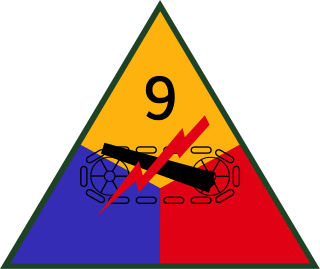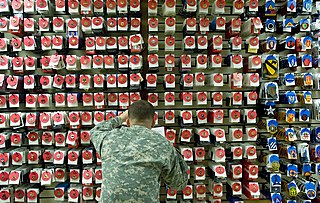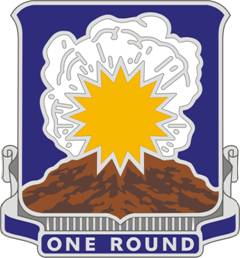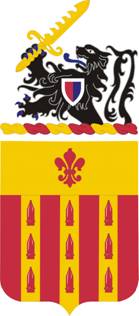Related Research Articles

The 101st Airborne Division is a light infantry division of the United States Army specializing in air assault operations. The Screaming Eagles were referred to as "the tip of the spear" by former U.S. Secretary of Defense Robert Gates and the most potent and tactically mobile of the U.S. Army's divisions by former Chief of Staff of the Army GEN Edward C. Meyer (ret). Today, the 101st Airborne is able to plan, coordinate, and execute multiple battalion-size air assault operations capable of seizing key terrain in support of operational objectives and is capable of working in austere environments with limited or degraded infrastructure. These operations can be conducted by mobile teams covering large distances and engaging enemy forces behind enemy lines. According to the author of Screaming Eagles: 101st Airborne Division, its unique battlefield mobility and high level of training have kept it in the vanguard of US land combat forces in recent conflicts. More recently, the 101st Airborne has been performing foreign internal defense and counterterrorism operations within Iraq and Afghanistan.

Anthony Clement "Nuts" McAuliffe was a senior United States Army officer who earned fame as the acting commander of the 101st Airborne Division defending Bastogne, Belgium, during the Battle of the Bulge in World War II. He is celebrated for his one-word reply to a German surrender ultimatum: "Nuts!" After the battle, McAuliffe was promoted and given command of the 103rd Infantry Division, which he led from January 1945 to July 1945. In the post-war era, he was commander of United States Army Europe.

The XVIII Airborne Corps is a corps of the United States Army that has been in existence since 1942 and saw extensive service during World War II. The corps is designed for rapid deployment anywhere in the world and is referred to as "America's Contingency Corps". Its headquarters are at Fort Bragg, North Carolina.

The 1st Infantry Division is a combined arms division of the United States Army, and is the oldest continuously serving division in the Regular Army. It has seen continuous service since its organization in 1917 during World War I. It was officially nicknamed "The Big Red One" after its shoulder patch and is also nicknamed "The Fighting First." The division has also received troop monikers of "The Big Dead One" and "The Bloody First" as puns on the respective officially sanctioned nicknames. It is currently based at Fort Riley, Kansas.

The 9th Armored Division was an armored division of the United States Army during World War II. In honor of their World War II service, the 9th was officially nicknamed the "Phantom Division."

The 10th Armored Division was an armored division of the United States Army in World War II. In the European Theater of Operations the 10th Armored Division was part of both the Twelfth United States Army Group and Sixth United States Army Group. Originally assigned to the Third United States Army under General George S. Patton, it saw action with the Seventh United States Army under General Alexander Patch near the conclusion of the war.

The Siege of Bastogne was an engagement in December 1944 between American and German forces at the Belgian town of Bastogne, as part of the larger Battle of the Bulge. The goal of the German offensive was the harbor at Antwerp. In order to reach it before the Allies could regroup and bring their superior air power to bear, German mechanized forces had to seize the roadways through eastern Belgium. Because all seven main roads in the densely wooded Ardennes highlands converged on Bastogne, just a few miles away from the border with neighboring Luxembourg, control of its crossroads was vital to the German attack. The siege was from 20 to 27 December, until the besieged American forces were relieved by elements of General George Patton's Third Army.
The 502nd Infantry Regiment, previously titled the 502nd Parachute Infantry Regiment, is an infantry regiment of the United States Army. The regiment was established shortly after the American entry into World War II, and was assigned as a regiment of the 101st Airborne Division, "The Screaming Eagles", one of the most decorated formations of the U.S. Army. The regiment saw substantial action in the European Theater of World War II and was inactivated in 1945, shortly after the end of the war. Reactivating in a new form in 1956, the 502d Infantry has served in the Vietnam War, the first Gulf War, Operation Iraqi Freedom, Operation Enduring Freedom in Afghanistan, and Operation Inherent Resolve in Iraq. Since 1974, the regiment has been classified as an Air Assault unit. Currently, its 1st and 2nd battalions are active. Both battalions are assigned to the 2nd Brigade Combat Team, 101st Airborne Division.

A distinctive unit insignia (DUI) is a metallic heraldic badge or device worn by soldiers in the United States Army. The DUI design is derived from the coat of arms authorized for a unit. DUIs may also be called "distinctive insignia" (DI) or, imprecisely, a "crest" or a "unit crest" by soldiers or collectors. The U.S. Army Institute of Heraldry is responsible for the design, development and authorization of all DUIs.

The 327th Infantry Regiment is an infantry regiment of the 101st Airborne Division of the United States Army. During World War II, the 327th was a glider-borne regiment of the 101st Airborne Division. It fought during World War I as part of the 82nd Division. It has also been deployed in the Vietnam War, Gulf War, and most recently to Iraq and Afghanistan. The song "Glider Rider" describes (humorously) some of the slights that glider-borne troops felt they received from the Army during World War II; though the regiment's public fame rose with the 1949 movie Battleground about the Siege of Bastogne in late 1944.
The United States Army Regimental System (USARS) was established in 1981 to replace the Combat Arms Regimental System (CARS) to provide each soldier with continuous identification with a single regiment, and to increase a soldier's probability of serving recurring assignments with his or her regiment. The USARS was intended to enhance combat effectiveness by providing the opportunity for a regimental affiliation, thus obtaining some of the benefits of the traditional regimental system.

MISSION

The 52nd Infantry Regiment is an infantry regiment of the United States Army.

The 333rd Field Artillery Battalion was a racially segregated United States Army unit of African-American troops during World War II.

The 705th Tank Destroyer Battalion was a tank destroyer battalion of the United States Army active during the Second World War. It was originally formed from artillery elements of the 5th Armored Division, and its lineage is today perpetuated by the 75th Cavalry Regiment.

The 32nd Armor Regiment was an armored regiment of the United States Army until 2000 at which time it was deactivated. It was redesignated and reactivated as the 32nd Cavalry Regiment serving in the 1st Brigade, 101st Airborne Division in 2005.
The 377th Field Artillery Regiment is a field artillery regiment of the United States Army. A parent regiment under the U.S. Army Regimental System, the regiment's 2nd Battalion, 377th Field Artillery Regiment is assigned to the 4th Brigade Combat Team, 25th Infantry Division. Elements of the regiment have also served with the 101st Airborne Division and 82nd Airborne Division, and have seen service in World War II, Vietnam, and in both Iraq and Afghanistan during the Global War on Terror. The 1st and 3rd Battalions as well as Batteries D and E are Inactive.

The 333rd Field Artillery Regiment is a regiment of the Field Artillery Branch of the United States Army.

The 101st Airborne Division Artillery (DIVARTY) is the force fires headquarters for the 101st Airborne Division at Fort Campbell, Kentucky. The DIVARTY has served with the division in World War II, Vietnam, Operations Desert Shield and Storm, Operation Iraqi Freedom, and in peacetime at Camp Breckinridge and Fort Campbell, Kentucky, and Fort Jackson, South Carolina. The DIVARTY was inactivated in 2005 as part of transformation to modular brigade combat teams, but was reactivated on 16 October 2014 to provide fire support coordination and mission command for the training and readiness of field artillery units across the division.
The 101st Airborne Division is a specialized modular light infantry division of the US Army trained for air assault operations. The Screaming Eagles has been referred to by journalists as "the tip of the spear" as well as one of the most potent and tactically mobile of the U.S. Army's divisions. The 101st Airborne Division has a history that is nearly a century long. During World War II, it was renowned for its role in Operation Overlord, Operation Market Garden, the liberation of the Netherlands and its action during the Battle of the Bulge around the city of Bastogne, Belgium. During the Vietnam War, the 101st Airborne Division fought in several major campaigns and battles, including the Battle of Hamburger Hill in May 1969. In mid-1968, it was reorganized and redesignated as an airmobile division and then in 1974 as an air assault division. In recent years, the division has served in Iraq and Afghanistan. At the height of the War on Terror, the 101st Airborne Division had over 200 aircraft. The division now has slightly over 100 aircraft.
References
- 1 2 3 4 5 http://www.history.army.mil/books/wwii/11-4/chapter21.htm
- 1 2 http://lestweforget.hamptonu.edu/page.cfm?uuid=9FEC3345-FDE7-5326-01EF58424224C02E
- ↑ Burgett, Donald R. (2002). Beyond the Rhine: A Screaming Eagle in Germany . Dell. ISBN 9780440236368 . Retrieved 29 April 2013.
- 1 2 3 "Chapter XXI: Artillery And Armored Units in the ETO". www.history.army.mil. Retrieved 15 May 2017.
- ↑ "Black Soldiers of the Ardennes :: World War II :: Ardennes :: Lest We Forget". lestweforget.hamptonu.edu. Retrieved 16 May 2017.
- ↑ "WERETH History". www.wereth.org. Retrieved 17 May 2017.